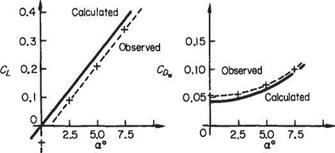Aerofoil section made up of unequal circular arcs
A convenient aerofoil section to consider as a first example is the biconvex aerofoil used by Stanton* in some early work on aerofoils at speeds near the speed of sound. In his experimental work he used a conventional, i. e. round-nosed, aerofoil (RAF 31a) in addition to the biconvex sharp-edged section at subsonic as well as supersonic speeds, but the only results used for comparison here will be those for the biconvex section at the supersonic speed M = 1.72.
Example 6.11 Made up of two unequal circular arcs a profile has the dimensions shown in Fig. 6.50. The exercise here is to compare the values of lift, drag, moment and centre of pressure coefficients found by Stanton* with those predicted by Ackeret’s theory. From the geometric data given, the tangent angles at leading and trailing edges are 16° = 0.28 radians and 7° = 0.12 radians for upper and lower surfaces respectively. Then, measuring x from the leading edge, the local deflections from the free-stream direction are
 |
for upper and lower surfaces respectively.
![]() T. E. Stanton, A high-speed wind channel for tests on aerofoils, ARCR and 1130,
T. E. Stanton, A high-speed wind channel for tests on aerofoils, ARCR and 1130,
|
|
|
|
|
Incidence degrees |
0 |
2-5 |
5-0 |
7-5 |
|
|
CL |
calculated |
0 |
0-125 |
0-25 |
0-375 |
|
observed |
-0-064 |
0-096 |
0-203 |
0-342 |
|
|
cD |
calculated |
0-044 |
0-0495 |
0-066 |
0-093 |
|
observed |
0-052 |
0-054 |
0-070 |
0-093 |
|
|
—Cm |
calculated |
0-039 |
0-101 |
0-164 |
0-226 |
|
observed |
-0-002 |
0-068 |
0-114 |
0-178 |
|
|
kcp |
calculated |
00 |
0-81 |
0-65 |
0-60 |
|
observed |
0-03 |
0-69 |
0-54 |
0-49 |
|
|
LID |
calculated |
0 |
2-5 |
3-8 |
4-0 |
|
observed |
-1-2 |
1-8 |
2-9 |
3-5 |
|
Fig. 6.51 |
It will be noted again that the calculated and observed values are close in shape but the latter are lower in value, Fig. 6.51. The differences between theory and experiment are probably explained by the fact that viscous drag is neglected in the theory.













